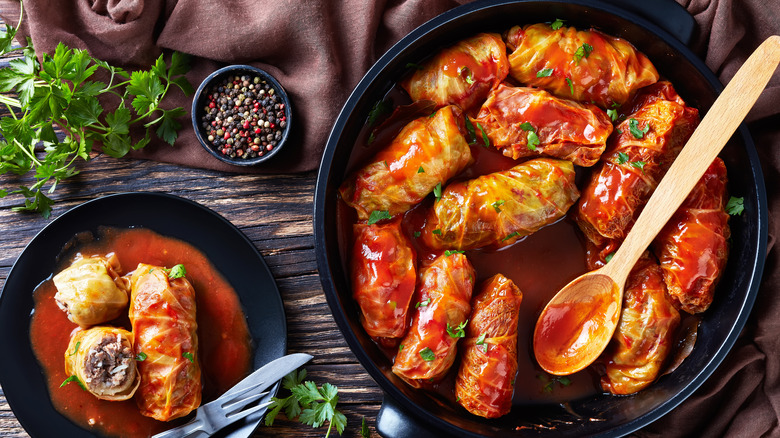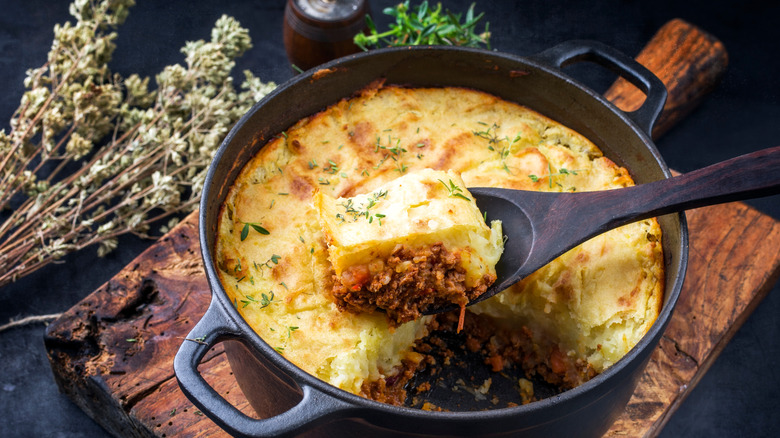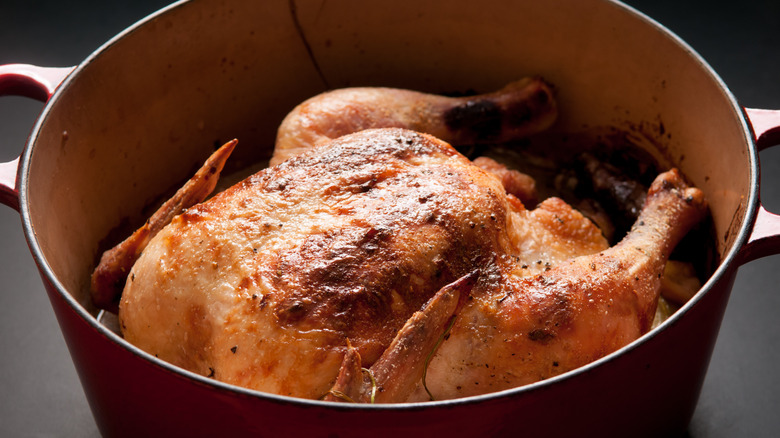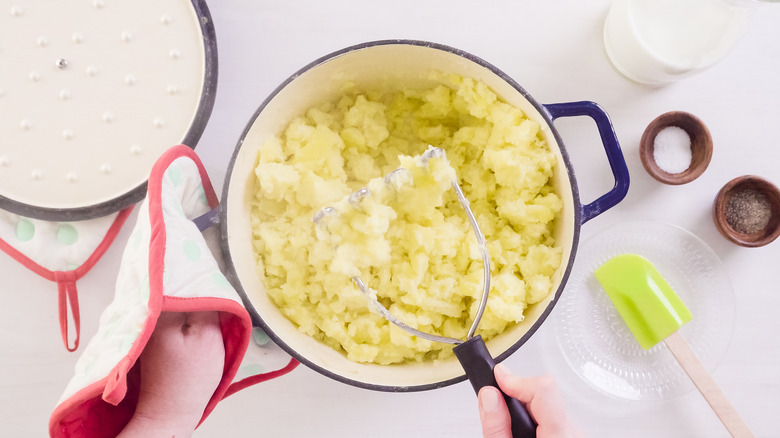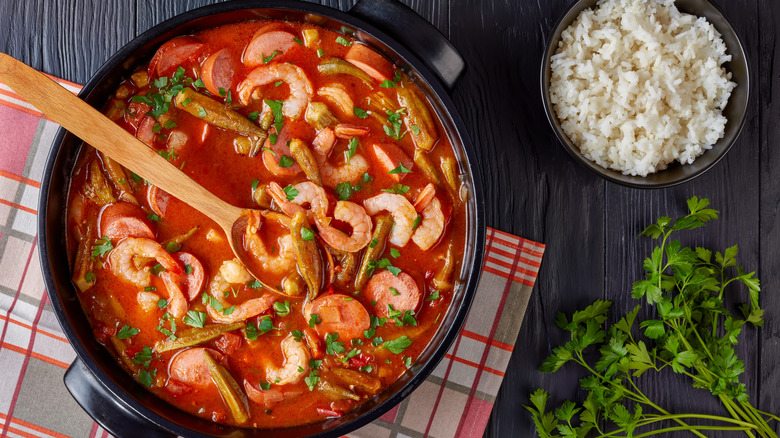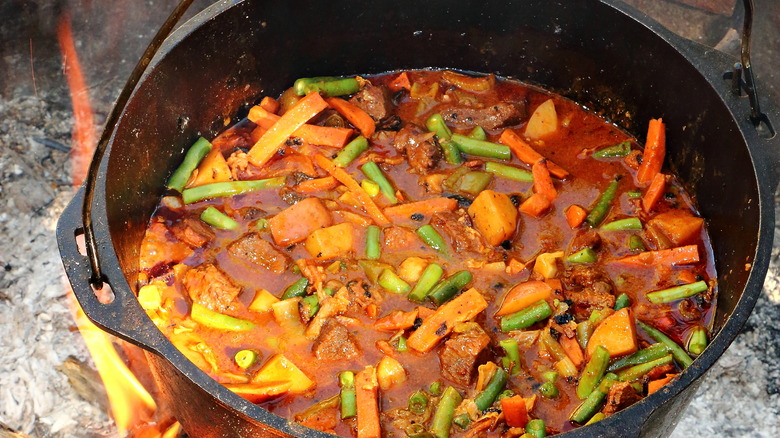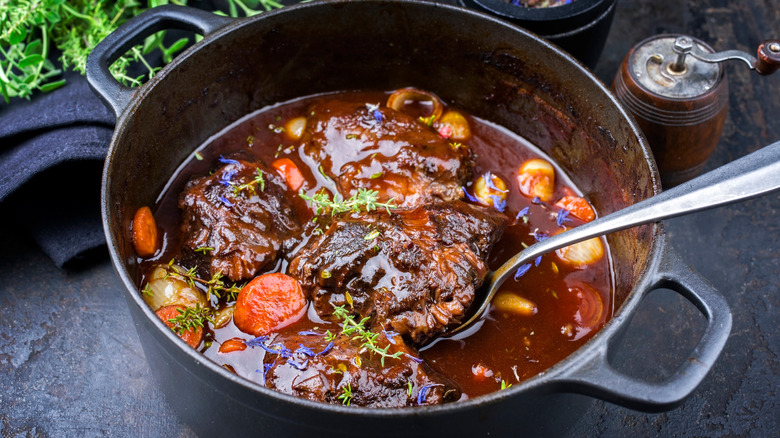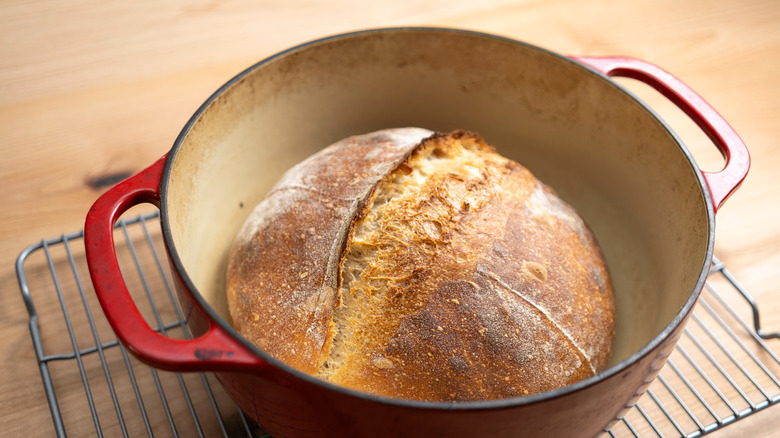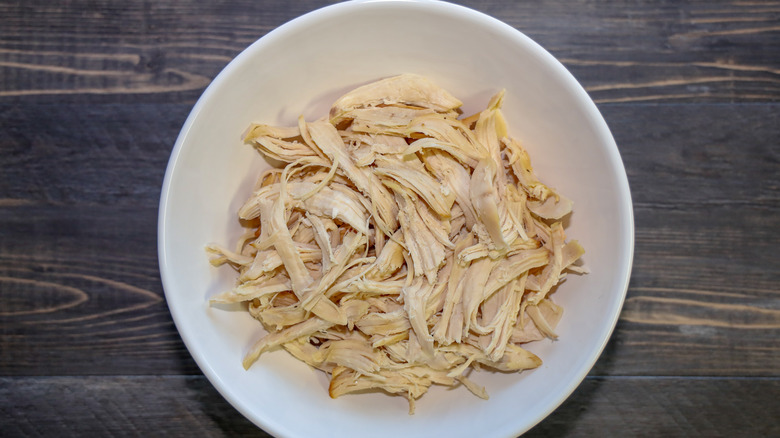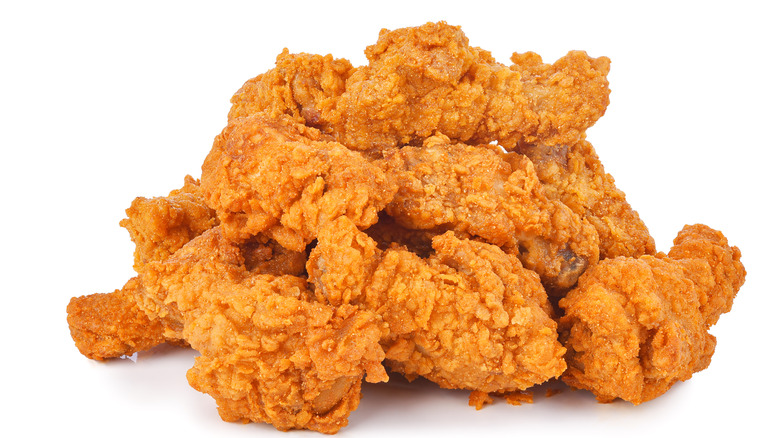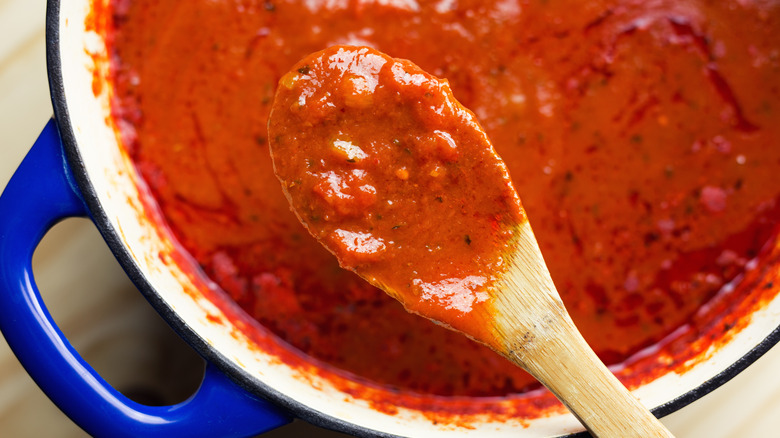The Best Ways To Use Your Dutch Oven
Dutch ovens are a quintessential part of a home kitchen, but many do not know just how versatile and essential this classic piece of cookware truly is. The Dutch oven often serves as the most important and most versatile cooking vessel in your kitchen. They're great for both the stovetop and the oven and can be used for everything from braising meat to making soups, stews, frying chicken, and so much more. Consider some uses that may not have occurred to you, like baking bread or even making a pot of sauce or gravy for pasta in the humble but ultra-useful Dutch oven.
"My Dutch oven has a permanent spot on my stovetop," Laura Pauli, chef at Cucina Testa Rossa said to Tasting Table. "I have something, bubbling, brewing, baking or braising it in just about every day so why bother to put it away?" Along with the cast iron pan, it is the workhorse of kitchen equipment. A good Dutch oven is sturdy, solid, and will last for a lifetime of cooking.
"I don't know that I could ever be without one!" Suzy Karadsheh, CEO and founder of The Mediterranean Dish, told Tasting Table. "I love the simplicity of a Dutch oven; it is basically a heavy-duty cast iron pot with a lid [...] it lasts for years, and you can buy one at an affordable price." Whether you already have one or are now contemplating getting your own, here are the best ways to use your Dutch oven.
Slow cooking and braising
A great benefit of Dutch ovens is that they can retain heat extraordinarily well while cooking, thanks to their heavy cast iron construction. That means they are great to cook low and slow, according to Real Simple, much like a classic slow cooker but without all of those cords and control panels. That's perfect for tender meats that taste their best when cooked low and slow, but there's another benefit to this method of cooking. Per Real Simply, you can "use the lid to create steam and trap moisture for even more flavorful and juicy dishes." This leads to greater depths of flavor, more control over the cooking process, and a beautiful final dish.
While a Dutch oven and a traditional slow cooker work in similar ways, there are some undeniable benefits to choosing a Dutch oven. This, according to OvenSpot, includes the heat source that is used. Remember that a Dutch oven is over an on a stove or potentially over an open flame, while a slow cooker is plugged into an external power source. This will impact how fast the food is cooked, of course, but also means that it's possible to sear in a Dutch oven, a typically difficult task in a classic slow cooker. These factors all can lead to way more flavorful food.
Roasting a chicken and making stock
Much like a Dutch oven is a mainstay of a kitchen with limitless possibilities, the same can be said for roasting a chicken and using that chicken to make stock — both can lead to countless meal options. Why not combine the two? "The Dutch oven is great for roasting because it helps to steam the chicken evenly while keeping the meat moist (very similar to why Dutch ovens are so great to bake bread in!)," Maille mustard sommelier, chef Brandon Collins, told Tasting Table.
"With the lid on, Dutch ovens help create convection as all sides heat evenly and therefore cook the chicken evenly," said Collins. Then, at the very end, you can remove the lid and let the skin crisp up in the drier heat of your oven, perhaps with a delicious mustard-based rub already applied before cooking to amp up the flavor, as Collins, recommends.
And don't throw away the parts when you're done eating, as that chicken can then become a perfectly flavored stock. "I have my grandmother's Dutch oven and I use it to make stock every week by first roasting a chicken in it, then I toss in any leftover vegetables and herbs in my fridge along with the chicken bones, cover, and simmer for a few hours," said Pauli. This will lead to some seriously delicious stock that you can use in all manner of applications, from sauces, to soups, to stew, and beyond.
Mashed potatoes
What is a great roast chicken without mashed potatoes to go along with it? Whether you enjoy the perfect potatoes for mashing with garlic, bacon, or loaded with everything you can find, mashed potatoes are a perfect side for many dinners. They're also a great application for a Dutch oven.
Because it's so great for cooking other low and slow meals, Dutch oven is also a fantastic way to make a big batch of perfectly cooked mashed potatoes. "I love using it to make mashed potatoes as, thanks to the thick steel which maintains even heat, I can make it a few hours ahead and, covered, they'll stay warm until dinner," said Pauli.
As the Dutch oven is safe both on the stovetop and also in the oven, a pretty handy move to keep it warm when you've made the side ahead of time. It should also be pretty easy to wash afterward. Tried and Tasty maintains that, because of the enamel coating on so many Dutch ovens, you can safely boil water, cook foods for extended periods, and potentially even wash them in the dishwasher.
Hearty soups and stews
One very common and classic way to use your Dutch oven is to make a hearty stew. "Dutch ovens are great for making stew because they conduct heat evenly around the food at all times and you can saute some of your ingredients before adding the liquids," Megan Byrd of The Oregon Dietitian told Tasting Table. If you can saute select ingredients before adding in the liquids, this can draw on caramelization and the Maillard reaction to create an even more rich depth of flavor in the final product.
Making beef stew in a Dutch oven can yield a flavorful, hearty, and delicious stew with fall-apart beef in less than two hours, according to Byrd. There are a few advantages of making a beef stew in a dutch oven. "You can sear the meat within the same pot and preserve the juices to add more flavor to the stew later," Victoria Yap, editor at Honest Food Talks, told Tasting Table. "A Dutch oven retains the cooking temperature and evenly distributes the heat which will tenderize the beef, giving you that fork-tender meat."
Finally, it's all in one pot! This, according to Yap, "saves a lot of hassle from cleaning up after cooking and it looks pretty to serve straight in the middle of the dinner table!" Hard to argue there!
Cooking outdoors
Dutch ovens shouldn't just be confined to the kitchen, especially not if you're a foodie who also loves the great outdoors. Dutch ovens are well suited for camping and outdoor gathering because they are a pot that food that can be prepared and cooked in, but then easily used for presentation and serving. Even in the less controlled conditions of a campsite, those thick-walled Dutch ovens also work wonders in keeping a meal warm while everyone gathers around. That's a one-pot solution from beginning to end, meaning there are simply fewer pots to gather and clean at the end of the evening.
"You can make all sorts of delicious recipes like apple cobbler, cassoulet, and even shepherd's pie, Collins told Tasting Table. To achieve this feat, simply "assemble the recipe in the Dutch oven, then bury it in the coals to essentially make an oven out of your fire."
It's a great way to use the same fire you may be using for heat or light to also cook a delicious outdoor dinner that will look beautiful on any table, even a rustic picnic table in the woods.
Braising meats
Chef Brandon Velie of Juniper in Ridge Spring, South Carolina told Tasting Table he loves to use his Dutch oven for braising meats. Indeed, he maintained that braising is his favorite method of cooking, and it's all thanks to the Dutch oven.
To braise in the Dutch oven, start off with meats that are well-marbled, as these are usually the cuts that tend to have a lot of flavor. "I personally like meat with the bone in like shanks, [since] the bone marrow helps add to the overall flavor as it cooks," said Velie. "I use a cast-iron Dutch oven and my secret is to sear the meat really well in the Dutch oven first then add whatever veggies you are using, then after a few minutes I add my liquid."
The leftover debris from searing on the bottom of the pan, called the fond, also helps increase the flavor when you take an extra minute to deglaze. At the end, it's all ready for showtime. "[T]he great thing about the Dutch oven is that I then put that on the table to serve out of as well. Visually it is really cool to use but it also helps cut down on the number of dishes that have to be washed afterward!" said Velie.
Baking bread
While Dutch ovens are often thought of in relation to casseroles and stews, it's also actually a perfect environment for baking bread. Properly prepared, a Dutch oven with the lid on creates plenty of extra steam to help develop the perfect crust of your loaf, as Taste of Home notes. "The way the Dutch oven works to distribute heat, it bakes evenly, doesn't dry out, and gives a lovely golden crust," chef Mark Tarbell of Phoenix told Tasting Table.
Yet another reason many people love making bread in a Dutch oven is its design. The heavy sides and enameled coating can allow for the bread to simply be stirred and then baked, which means that all that effort that goes into shaping and kneading can sometimes be skipped, depending on the particular bread in question. That makes this bread nearly error-proof, and a surefire recipe for success. The steam from the Dutch oven will bake up the dough with that golden, crunchy crust that we all crave when we make bread, and will do so with a perfectly round shape.
The Dutch oven is perfect for rustic bread like cornbread, for example. If you're feeling extra adventurous and have some extra time as well to monitor the process, you can even use it to make some classic sourdough.
Poaching
If you love a tender, fall apart and flavorful chicken, poaching may be the answer for you when it comes to dinner time, and the Dutch oven may be the best way to do that poaching. Poaching, according to The Spruce Eats, is a cooking method that keeps dishes like chicken moist and juicy and avoids the unappetizing dried out meat that sometimes comes from other cooking methods by cooking at a low temperature in liquid.
That is because the deep, wide Dutch can hold enough liquid, be it water or broth or sauce, in order to cover the protein and keep the heat right where you want it. That leads to a gentle simmer with beautiful results. Plus, as Bob's Red Mill notes, a Dutch oven's deep sides and excellent heat retention can contain a large number of ingredients, all while giving it room to cook up just right.
Frying
Frying can be a daunting task — and a messy one at that. The tall sides of a Dutch oven help to cut down on oil splatter, and the cast iron handles very high heat without burning. "The depth of the cast-iron Dutch oven offers up a glorious opportunity to try your hand at deep-frying food," OvenSpot reports. That's especially helpful if you don't want to spring for a less versatile piece of kitchen equipment like a dedicated deep fryer.
And whether frying a classic like chicken or something a bit more creative, like fresh homemade doughnuts, the results are going to be darn near perfect. "I love Dutch ovens for frying homemade spoon doughnuts," Tarbell said. The heavy base makes for a more gentle distribution of heat, which helps to ensure that the cooking oil is evenly heated and ready to fry. However, you may need to exercise a bit of patience and keep an eye on the oil's final temperature. Because of the heavy nature of the Dutch oven, the oil temperature will be slow to adjust, said Tarbell, who recommends 325° F as a good base temperature for many fried recipes.
Gravy and sauce
Whether making a batch of gravy for a hearty brunch of biscuits or an Italian-style marinara for pasta night, a Dutch oven can be a fantastic vehicle for simmering and steaming sauces and gravies. "This is right from my childhood," said Tarbell. "My best friend's mom used to have a heavy-bottomed pot on the back burner of the stove running all the time. It was tomato-based but essentially loaded with scraps."
When cooking a sauce or gravy, slow and low is the way to go for many applications, meaning the sturdy, heat-retaining base and walls of the Dutch oven are well suited to the task. The Dutch oven also does really well to hold and distribute the heat in ways that a regular pot cannot. "It allows each flavor to cook perfectly even and creates an end product that is smooth and delicious," said Tarbell. Now, all you'll need is a crusty loaf of bread to sop up all that delicious sauce!
